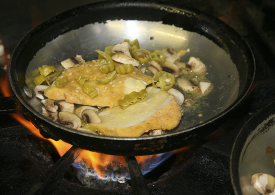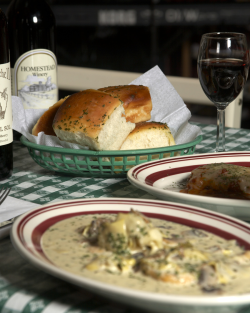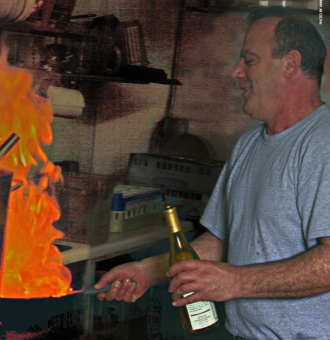This article appeared in the Spring 2007 issue of Texoma Living!.
The Restaurant Business is 24/7 and Frank Devolli Wouldn’t Have It Any Other Way.
It’s small for a restaurant kitchen. The four-burner commercial range sits between a sink and a waist-high cooler, which in turn rubs against a multi-level baking oven and warmer. On the weekends, when Devolli’s Italian Restaurant is jumping with customers waiting for dinner, Frank Devolli and his assistant have to watch out, lest they collide somewhere around the tall pot of red tomato sauce that usually sits on the corner of the range.
Devolli says he is planning to push out the north wall and expand the kitchen. He’ll add another range and maybe some more prep room. One thing he won’t add is a microwave. He doesn’t like them; he’s not a microwave kind of guy. It’s not the way he learned to cook.
He learned the old fashioned way of doing things, which is appropriate as he is from a part of the world with very old culinary traditions. He was born Albanian, but moved with his family across the Adriatic to Italy at an early age. With relatives in both countries, he grew up influenced by both cultures.
His family ran a small café with a mix of dishes on the menu, some Italian, some Eastern European. “We eat goulash, for example,” Devolli said, “and Northern Italian food. In Northern Italy we use more butter, but when you cook a southern dish you use olive oil.”
At 17, speaking no English and by himself, Devolli came to America. He came for the same reason so many had come before him. “For more freedom. You could open your own business,” he said.
He had a school friend who lived in Chicago with his family, so that’s where Devolli started out. They helped him find a job as a busboy in a restaurant, and Frank began the long apprenticeship that was the traditional way to become a chef. “I was in Chicago for seven years. I worked in several places and became a cook and then a chef.” Simply said; not so simply done.
New York City was next. “I thought there were more and better jobs there and you could make more money.” Devolli said. “I started working in better restaurants, more classy, higher chefs.” He spent time learning the specialties of the cooks he worked for. “I stay behind them to learn what they do.” There were other restaurants and other chefs to follow around, but all of them specialized in Italian food.
Devolli’s brother-in-law had a restaurant in Richardson, Texas, so in 1992 it was “Arrivederci Big Apple, Ciao, Big D.” He worked for this brother and then, for five years he had his own place called Nero’s Pizza and Pasta in Dallas, but it was a tough market, and things didn’t always go the way Devolli wanted. “Too much competition,” he said. “So I came to Denison.” He worked for Sali’s, Denison’s solo Italian place for a while and then, about two years ago, made another change.
Gabe and Barbara Parker turned the old jewelry shop on Main Street in Denison to a tasting room and retail store for the wines they produced at the Homestead Winery in Ivanhoe. They had started the vineyards and wine making operation on land that had been in the Parker family for more than a century. The winery in North Fannin County was not exactly on the beaten track, so in time they opened the place in Denison.
They got the building next door, the old Star Theater, and made it a warehouse where they blended port and sherry. Early on, they leased space in the back of the store to a food operation.
 “I wouldn’t call it a restaurant,” said Gabe Parker. “We’d had a sandwich shop, two different ones, that were open for lunch. I don’t want to own a restaurant; it’s enough to run three wineries, so we always had other people do it.”
“I wouldn’t call it a restaurant,” said Gabe Parker. “We’d had a sandwich shop, two different ones, that were open for lunch. I don’t want to own a restaurant; it’s enough to run three wineries, so we always had other people do it.”
The other people didn’t do it all that well, and both efforts failed. “When the second one pulled out, I mentioned to Tony Kaai of the Denison Development Alliance that I was looking for someone, and the next thing I know, Frank comes driving up. He came in, looked around, and said, ‘I will do restaurant here!’”
It was a big change for Parker. It meant more days and longer hours, but they went ahead with the plan. It has worked out very well for the winery. “He brought in the business and helped define our brand of wines,” Parker said. “He packs them in probably four nights a week and does a good lunch business too.
“The thing I enjoy about Frank is, well, he’s kind of like me— he’ll try any idea once. Ideas that work, you keep on; ideas that don’t, you do something else. He’s been very receptive to doing new things.”
The connection with Homestead, whose wines are featured in the restaurant, has been very beneficial to the winery in ways one would expect and ways one would not. “Our wine sales over there have skyrocketed,” said Parker. “Plus it does this; it ties food with wine together in a dinner setting that has not been seen around here before.” Parker said that being able to try different types of wine and get the response from the restaurant’s customers right there on the spot has a great impact on what he is doing in the winery.
Devolli’s also is changing the way people eat out in Texoma. “It brings a more European way of dining, and that’s something we haven’t had before. Normally your dinner crowd will come into a restaurant and spend 30 or 40 minutes. We’ve got people who will come in and spend two hours. That’s not North Texas.”
Neither is the menu; it’s Italian from A to Z, the A being the artichoke hearts and the Z being ziti. Devolli is often in the kitchen by seven in the morning. There’s sauce to make, bread to bake and all of the bits and pieces of prep work required to make ready for the day. This morning he’s having problems with the garlic butter. Not big problems, but problems. Someone forgot to take the blocks of butter out of the cooler to soften up, and the blender is straining under the load. Devolli adds chopped garlic by the spoons full, and as the mixture begins to smooth out, he pours in a steady steam of olive oil.
The ever-present, tall stock pot is on the corner of the range, bubbling red with fresh tomatoes and what ever mysterious bits of alchemy go into to brew. Every now and again, Devolli gives it a stir. He’s the only one in the kitchen. His assistant cook is on vacation, so Frank has to do it all. “He’s good,” says Devolli, speaking of his assistant. “He knows everything in the kitchen.”
For the last year or so, Devolli has had a chef in training. That’s a fancy name for the high school kid who washes dishes and keeps a close eye on what the chef does. That’s the way Frank learned, and he has hope for his protégé. “He a smart kid; it doesn’t take him too long and he’s learning.”
 Just because a dish is not on the menu or listed as a daily special is no reason to think it’s not available. Just ask Frank. “Yesterday some customers come in and say, ‘Frank, we want something new.’ So I made it. I made a chicken Florentine. Spinach and vegetables and ricotta cheese inside. With a pink sauce.” He said he made two orders, and when another table saw it, two more, and then two more. “The waiter ask how much he should charge, and I said ‘I don’t know, I’ll figure it out,’ and the customers just nodded.”
Just because a dish is not on the menu or listed as a daily special is no reason to think it’s not available. Just ask Frank. “Yesterday some customers come in and say, ‘Frank, we want something new.’ So I made it. I made a chicken Florentine. Spinach and vegetables and ricotta cheese inside. With a pink sauce.” He said he made two orders, and when another table saw it, two more, and then two more. “The waiter ask how much he should charge, and I said ‘I don’t know, I’ll figure it out,’ and the customers just nodded.”
It’s the personal touch, and not just the good fare that keeps the customers happy. Elton and Shirley Clark of Sherman have been Devolli regulars since the restaurant opened, and Elton explained why they keep coming back. “We had one extraordinary experience, whereby my daughter in Virginia surreptitiously arranged a magnificent Father’s Day dinner with wine for her mom and me. And above and beyond the call of duty, one of their staff people, Donna Holt, wrote a poem commemorating the event and presented it to me in a leather case.”
That’s a good place to end this story, although some cannoli or spumoni or tiramisu would make for a nice ending too.
Mozart’s Piano Sonata in A, K.331 is a variation on a theme. In that way, his music is much like great food.
While harmony, melody, rhythm, timbre and orchestration serve the composer, the ingredients that great chefs use to produce their variations on a theme are more down to earth. Wine, mushrooms, spinach, truffles, or the myriad of spices and herbs; in fact every thing in the kitchen can be used to create everything a bit different from something else.
This is particularly true with restaurant cuisine. The chef cannot devote hours to a single dish and expect the other diners to wait patiently, so the menu is a carefully planned to off a myriad of different endings from the same basic beginnings.
Two of Frank Devolli’s most popular dishes—Chicken Carchofie and Chicken Capocino demonstrate this concept very well.
Both start with breasts of chicken, skinned and boned. The supremes are lightly breaded and then browned in butter.
The Carchofie gets the chef’s spices and hearts of artichoke and white wine. The Capocino is made with mushrooms, pepperocini peppers and white wine. As the ingredients simmer in the pans, both get a sauce made with white wine, butter and cream. Just before the Capocino is finished, the chef adds a splash of red tomato sauce and the dish changes from white to pink.
Add spaghetti and plenty of fresh, hot bread to gather in the last remaining wisps of sauce when the meal is finished and you are dining well indeed.
How To Eat Spaghetti
Many non-Italians don’t know how to eat spaghetti. This is true even for the U.S., in spite of the large Italian community. Italian table manners when you are in front of a dish of spaghetti are very simple.
First of all keep your hands on the table throughout the meal and no elbows, and wait for everyone to be served before starting to eat.
The most common mistake is to load too much pasta on the fork. If you decide it’s too big or too long, drop it down and pick up a smaller bunch. Roll it again until you form a precise bundle, just the right size to go into your mouth.
 More mistakes to avoid:
More mistakes to avoid:
– Don’t slurp. Absolutely no sounds of any kind.
– Don’t splatter. Spaghetti can sometimes splatter the sauce. So be careful, but don’t wear a napkin as a bib unless you are a small kid.
– Avoid spaghetti for large or formal parties. Short pasta (rigatoni, penne, etc.) are much easier to serve and to eat.
– Scarpetta (meaning “little shoe”), is a technique used when eating pasta sauce. It is so delicious that every little bit should be wiped out of the dinner plate with a piece of fresh bread. It is not proper to do the Scarpetta at a formal dinner. If you are in an informal setting instead, compliment the cook and ask your guests for permission to make a Scarpetta. They will all agree with you with a big smile.
– Don’t use the spoon when eating spaghetti to help you wrap the pasta. It is considered bad form. Spaghetti should be eaten with the fork only.
– Never cut the threads of pasta with the knife or the fork. Spaghetti is sold in the right length, about 10-inches long, and that is just the right size.
Spaghetti is served in a piatto fondo, a deep bowl like a shallow soup-dish with a rim. Make room at the front of the bowl by pushing the spaghetti a little toward the center. Take a little bunch of the spaghetti with the prongs of the fork. Push it against the front side.
Now, working with the fork in a vertical position, and the prongs against the rim of the bowl, twirl the fork clockwise with your fingers to roll the spaghetti around your fork. Raise the fork with the spaghetti wrapped around it above the bowl, and measure the length with your eyes.
—Anna Maria Volpi

